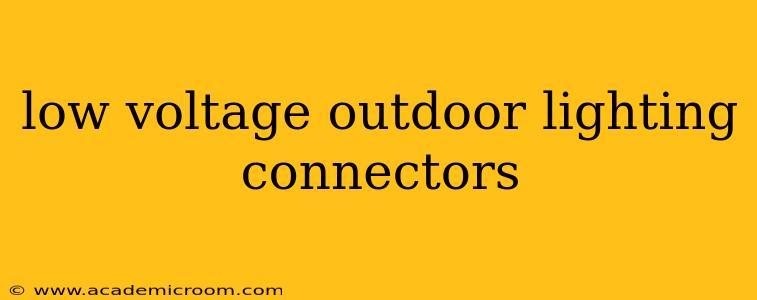Outdoor low-voltage lighting offers a stylish and energy-efficient way to illuminate your landscape. However, the success of your lighting project hinges on reliable connections. Choosing the right low-voltage outdoor lighting connectors is crucial for ensuring longevity, safety, and optimal performance. This guide will delve into the various types of connectors, their applications, and factors to consider when selecting the best ones for your needs.
What are Low Voltage Outdoor Lighting Connectors?
Low-voltage outdoor lighting connectors are specialized electrical components designed to securely connect the wires of your low-voltage lighting system. Unlike high-voltage systems, low-voltage systems (typically 12V or 120V) operate at lower voltages, reducing the risk of electric shock but still requiring robust and weatherproof connectors to prevent corrosion and short circuits. These connectors are designed to withstand the elements, ensuring the continued operation of your lights even in harsh weather conditions.
Types of Low Voltage Outdoor Lighting Connectors
Several types of connectors are commonly used in low-voltage outdoor lighting systems. The best choice depends on the specific application and personal preference.
1. Wire Nuts:
While simple and inexpensive, wire nuts are generally not recommended for outdoor low-voltage lighting. Their lack of weatherproofing makes them susceptible to moisture, leading to corrosion and potential hazards. They are suitable only for indoor, dry applications.
2. Push-in Connectors:
These connectors offer a quick and easy connection method, simply requiring you to push the wires into the designated slots. However, ensure they are specifically rated for outdoor use and are sufficiently weatherproof. Check the ratings carefully before using them.
3. Spring Connectors:
Similar to push-in connectors, spring connectors use a spring mechanism to secure the wires. They offer a slightly more secure connection than push-in types, but again, choose only those rated for outdoor use. These are a good option for quick, simple connections.
4. Waterproof Connectors:
These connectors are specifically designed for outdoor use, boasting weatherproof seals to protect against moisture, dust, and other environmental factors. They often feature a locking mechanism to ensure a secure and reliable connection. This is the most recommended type for outdoor applications. Look for connectors with a high Ingress Protection (IP) rating, such as IP65 or higher.
5. Crimp Connectors:
These require a special crimping tool to secure the connection. They provide a very secure and reliable connection, but require more specialized tools. They are excellent for permanent connections and are also highly weatherproof when correctly crimped.
How to Choose the Right Low Voltage Outdoor Lighting Connectors?
Several factors should guide your choice:
- Weather Resistance: This is paramount. Look for connectors with a high IP rating to ensure protection against moisture, dust, and other elements.
- Ease of Use: Consider your skill level and the complexity of the installation. Some connectors are easier to use than others.
- Durability: Choose connectors made from high-quality materials that can withstand the stresses of outdoor conditions.
- Compatibility: Ensure that the connectors are compatible with the gauge of wire used in your lighting system.
- Cost: While cost is a factor, don't compromise on quality. A cheaper, less durable connector could lead to costly repairs down the line.
H2: What are the different types of low-voltage lighting systems?
Low-voltage lighting systems generally fall into two categories: 12-volt and 120-volt. 12-volt systems are commonly used for landscape lighting, path lighting, and other low-power applications. They are safer to work with and often use smaller gauge wires. 120-volt systems might be used for brighter outdoor lighting fixtures and offer higher wattage options but require more stringent safety precautions. The type of system will influence your connector choices, as different voltage systems may require different connector types or ratings.
H2: How do I ensure a weatherproof connection for my low voltage outdoor lights?
Creating a weatherproof connection is crucial to the longevity and safety of your low-voltage outdoor lighting system. Beyond choosing weatherproof connectors, ensure all wire splices are protected with waterproof sealant. Consider using heat-shrink tubing over the connection after it's made to provide an extra layer of protection. Properly burying the wire and using appropriate conduit can further protect the connections from the elements. Always refer to the manufacturer's instructions for your specific connectors and lighting system.
H2: Are there any safety precautions I should take when working with low voltage outdoor lighting?
While low-voltage systems are safer than high-voltage systems, certain precautions are still necessary:
- Always turn off the power: Before connecting or disconnecting any wires, always turn off the power supply to the system to avoid electrical shock.
- Use appropriate tools: When using crimp connectors, make sure you have the right crimping tool to ensure a secure connection.
- Work with dry hands: Avoid working with wet or damp hands to prevent electric shock.
- Follow manufacturer instructions: Always carefully read and follow the instructions provided by the manufacturer of your lighting system and connectors.
By selecting the appropriate low-voltage outdoor lighting connectors and following proper installation techniques, you can ensure your outdoor lighting system functions reliably and safely for years to come. Remember, investing in quality connectors is an investment in the longevity and safety of your project.
